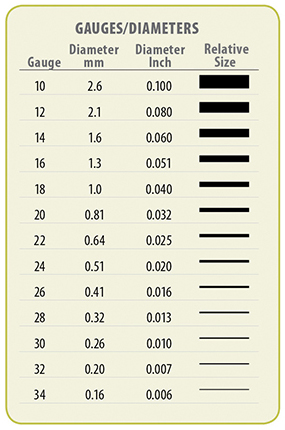
When it comes to using Artistic or Craft Wire, how do you know what to use when? We've put together this handy guide!
| Artistic Wire is available in the largest selection of exclusive Colours and Gauges that offer striking beauty and shine. Choose colours that complement one another to achieve warm, colourful designs. Or, make a statement and add drama to your designs by using contrasting colours. The only limit in working with coloured wire is your imagination!
Tip: As the wire diameter gets larger, the gauge number gets smaller (and vice versa). While the images on this page are visual representations of the gauge sizes relative to each other, the diameters stated are the actual physical size. Please use the stated gauge/diameter when choosing the size of your wire. |
12 gauge
• neck collars
• bracelets, cuffs, bangles
• rings
• frames / structure wire
12 gauge wire is usually only available in dead soft temper. It may require heavy duty jewellery makingtools for shaping and cutting.

14 gauge
• clasps
• thick jump rings
• neck collars
• rings
• bracelets, cuffs, bangles
• frames / structure wire
14 gauge wire is often only available in dead soft temper in most materials. It may require some heavy
duty jewellery making tools for shaping and cutting.

16 gauge
• frames / structure wire
• clasps
• thick jump rings, chainmaille jewellery
• rings
• bracelets, cuffs, bangles
• neck collars
16 gauge wire may be available in either dead soft of half hard temper in some materials. It can require heavy duty jewellery making tools for shaping and cutting.

18 gauge
• bails
• large jump rings, chainmaille jewellery
• frames / structure wire
• bracelets
• rings
• delicate clasps
• neck collars
• other handmade components
18 gauge wire can be shaped by hand and with the use of regular jewellery making tools (for shaping and cutting)

20 gauge
• earwires
• hoop earrings
• frames
• spirals
• headpins, eyepins
• open link chains
• delicate clasps, double wrapped hooks
• jump rings, split rings
• rings
• wire settings for medium stones
• bails for light stones
20 gauge wire is also good for a variety of other delicate handcrafted findings, like links or looped chandelier earring components. It can be shaped by hand and with the use of regular jewellery making tools

22 and 21 gauge
• wirewrapped links
• open link chains (for light or small stones)
• earwires
• headpins, eyepins
• jump rings
• spirals
• frames
• small clasps
• wire settings for small to medium stones
• 21 gauge is preferred by many for prong settings and earwires
21 and 22 gauge wire can be shaped by hand and with the use of regular jewellery making tools.

24 gauge
24 gauge wire is a very versatile wire and is one I buy and use in great quantities. 24 gauge wire can be used for:
• coiling
• weaving
• binding
• spirals
• headpins
• wirewrapped links, wrapping briolettes and other stones
• frames*
• small jump rings
• head pins
• wire settings for small stones
24 gauge wire is not recommended for open link chains in most cases. It can be used as a frame to wrap smaller wire around in some applications* – like earrings, when the finished piece is not structural. It can be shaped by hand and with the use of regular jewellery making tools.

26 gauge
26 gauge wire is still quite fine but is relatively strong. It is generally used for:
• coiling
• weaving
• knitting / crocheting
• wire wrapping (wrapped loops) small beads and briolettes
• wrapping around stones
• balled headpins
26 gauge wire can be shaped with the use of regular or fine tipped jewellery making tools. It should not be used as structure wire or open loop links.

28 – 30 gauge
This wire is tiny and fine, like thread. It can become kinked and break easily, so it is best to work slowly with these small gauges of wire. At this size, the temper (or hardness) of the wire doesn’t really mean much as it is so fine that it’s easily pliable. 28 – 30 gauge wire is used for:
• coiling
• weaving
• knitting / crocheting / viking knitting
• 28 gauge wire can also be used for wire wrapping very small light beads, though the finished wraps will be very delicate and could bend and break quite easily. These small wires are not suitable as structure wires (to wrap other wire around), nor should they be used for open loop links. Use regular or fine tipped jewellery making tools to shape and cut.


